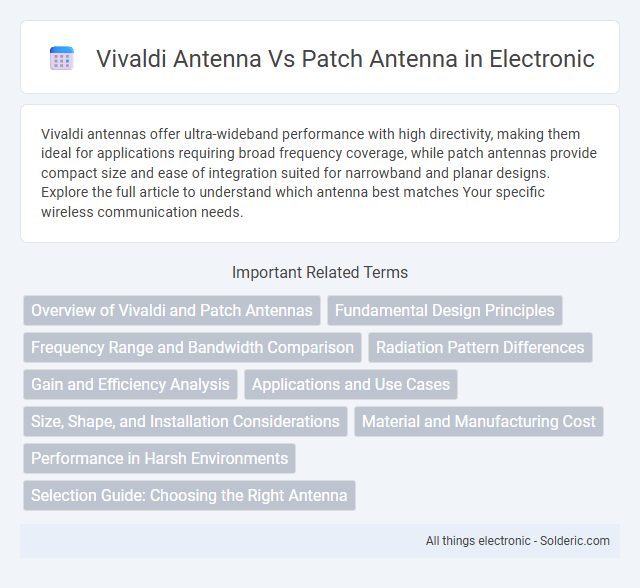Vivaldi antennas offer ultra-wideband performance with high directivity, making them ideal for applications requiring broad frequency coverage, while patch antennas provide compact size and ease of integration suited for narrowband and planar designs. Explore the full article to understand which antenna best matches Your specific wireless communication needs.
Comparison Table
| Feature | Vivaldi Antenna | Patch Antenna |
|---|---|---|
| Type | Planar tapered slot antenna | Microstrip antenna |
| Frequency Range | Wideband, from UHF to mmWave | Narrowband, typically VHF to GHz range |
| Bandwidth | Very wide (up to several GHz) | Limited bandwidth (usually a few % of center frequency) |
| Polarization | Linear, can be designed for dual polarization | Linear or circular polarization |
| Gain | Moderate to high (6-12 dBi) | Low to moderate (3-9 dBi) |
| Radiation Pattern | End-fire directional pattern | Broadside directional pattern |
| Size | Relatively large due to taper length | Compact and low-profile |
| Applications | Wideband communication, radar, UWB sensing | Mobile devices, GPS, WLAN, RFID |
| Fabrication | Requires precise taper shaping | Simple PCB fabrication |
Overview of Vivaldi and Patch Antennas
Vivaldi antennas are tapered slot antennas known for their ultra-wideband frequency coverage and high gain, making them ideal for broadband and radar applications. Patch antennas, typically microstrip designs, feature a flat, low-profile structure suited for narrowband applications such as mobile devices and GPS due to their compact size and ease of fabrication. Your choice depends on whether you prioritize broad frequency range and directional gain (Vivaldi) or compact design and integration flexibility (patch).
Fundamental Design Principles
Vivaldi antennas utilize an exponential tapering slot design to achieve wideband performance and high directivity, allowing efficient radiation over a broad frequency range. Patch antennas rely on a resonant cavity formed by a metallic patch over a ground plane, designed for narrowband operation with specific resonant frequencies. The fundamental distinction lies in the traveling-wave mechanism of Vivaldi antennas versus the standing-wave resonance characteristic of patch antennas.
Frequency Range and Bandwidth Comparison
Vivaldi antennas exhibit ultra-wideband frequency range, typically spanning from 1 GHz to over 20 GHz, offering high bandwidth efficiency crucial for broadband applications. Patch antennas generally operate within a narrow frequency range, commonly limited to a specific band such as 2.4 GHz or 5 GHz for Wi-Fi, with bandwidths typically around 2-5%. The expansive bandwidth of Vivaldi antennas enables superior performance in wideband and multi-frequency systems compared to the more frequency-specific patch antennas.
Radiation Pattern Differences
Vivaldi antennas exhibit a wide bandwidth and directional radiation pattern with low side lobes, making them ideal for broadband applications requiring high directivity. Patch antennas, characterized by a narrow bandwidth, typically produce a broadside radiation pattern with moderate gain and a wider beamwidth suitable for simpler, low-profile applications. The radiation pattern of a Vivaldi antenna is more focused and elongated, whereas a patch antenna's pattern is more uniform and hemispherical.
Gain and Efficiency Analysis
Vivaldi antennas typically offer higher gain and better broadband performance compared to patch antennas, making them suitable for wide frequency applications. Patch antennas exhibit moderate gain but generally achieve higher efficiency in narrowband operations due to their simpler structure and lower losses. Analysis shows Vivaldi antennas provide gain levels ranging from 8-15 dBi with efficiencies around 70-85%, whereas patch antennas deliver gain around 5-9 dBi with efficiencies often exceeding 80% in their optimized frequency bands.
Applications and Use Cases
Vivaldi antennas excel in ultra-wideband applications such as radar systems, microwave imaging, and wireless communication, benefiting from their high gain and directional capabilities. Patch antennas are widely used in satellite communication, GPS devices, and mobile phones due to their compact size and ease of integration on printed circuit boards. Your choice depends on the need for bandwidth and radiation pattern; Vivaldi suits broadband sensing, while patch antennas fit fixed-frequency, space-constrained environments.
Size, Shape, and Installation Considerations
Vivaldi antennas are generally larger and feature a tapered exponential shape suited for wideband applications, while patch antennas are more compact, flat, and rectangular, optimized for narrowband or specific frequency use. The size and shape of Vivaldi antennas often require more installation space and precise alignment due to their directional nature, whereas patch antennas are easier to mount on flat surfaces and integrate into compact devices. Your choice between these antennas should consider the available installation area and the desired frequency range to ensure optimal performance and space utilization.
Material and Manufacturing Cost
Vivaldi antennas are typically made from printed circuit board materials like FR4 or Rogers substrates, which offer moderate cost benefits but require precise fabrication to maintain their tapered slot geometry. Patch antennas often use low-cost substrates such as FR4 or ceramic-loaded laminates, allowing for mass production via standard photolithographic processes, resulting in lower manufacturing expenses. Your choice depends on balancing the slightly higher material and fabrication complexity costs of Vivaldi antennas against the cost-effective scalability of patch antenna production.
Performance in Harsh Environments
Vivaldi antennas exhibit superior performance in harsh environments due to their wide bandwidth and robust planar design, enabling reliable signal transmission under extreme temperature and moisture conditions. Patch antennas, while compact and easy to integrate, often suffer from reduced efficiency and vulnerability to environmental factors like corrosion and physical damage. Choosing the right antenna ensures your system maintains consistent communication quality despite challenging environmental stresses.
Selection Guide: Choosing the Right Antenna
When selecting between a Vivaldi antenna and a patch antenna, consider your application's frequency range and bandwidth needs, as Vivaldi antennas offer wideband performance while patch antennas excel at narrowband, high-gain applications. Your choice should also factor in the antenna's size constraints and radiation pattern requirements; Vivaldi antennas provide directional beams with good gain over broad frequencies, whereas patch antennas deliver compact designs with stable, consistent radiation patterns. Evaluating these parameters ensures optimal antenna performance tailored to your communication or sensing system.
Vivaldi antenna vs patch antenna Infographic

 solderic.com
solderic.com